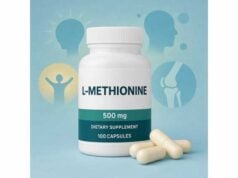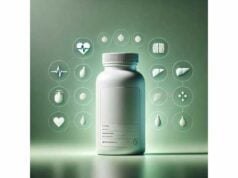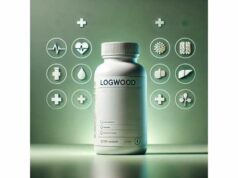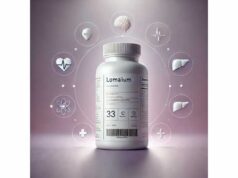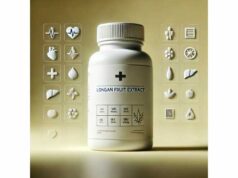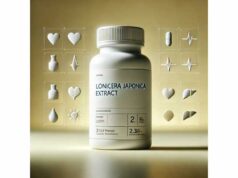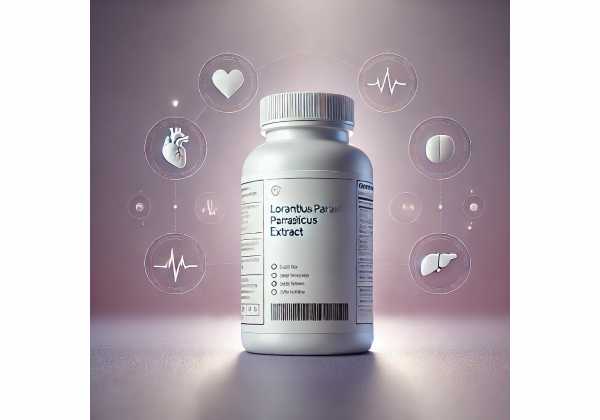
Loranthus parasiticus—often listed in English as a parasitic “mistletoe” and known in parts of East and Southeast Asia as Sang Ji Sheng—has been brewed as a tonic for joints, steadier pregnancy, and calm nerves for centuries. Modern lab work highlights antioxidant, anti-inflammatory, neuroprotective, and antiallergic signals from its leaves and stems, with lignans, flavonoids, and proanthocyanidins leading the way. Today you will find it as a single-herb extract in capsules or granules and, more often, inside classic combination formulas for musculoskeletal comfort and general “wind-damp” patterns. This guide focuses on people-first, practical details: what Loranthus parasiticus extract actually contains, where the evidence is strongest (and where it is thin), how to use it day to day, realistic dosage ranges for both decoctions and standardized products, safety guardrails, and a buying checklist so you can choose a credible preparation. Expect supportive—not miraculous—benefits that make the most sense when paired with rest, movement, and your clinician’s advice.
Essential Insights
- Most reliable signals: antioxidant, anti-inflammatory, and antiallergic actions that may support joint and airway comfort.
- Key constituents: lignans (e.g., nortrachelogenin, trachelogenin, matairesinol), flavonoids, and proanthocyanidins that act on NF-κB and related pathways.
- Practical ranges: 9–15 g/day dried herb in decoction (short courses) or 250–1,000 mg/day standardized extract.
- Caution: avoid during pregnancy and breastfeeding despite traditional mentions; discuss with your clinician if you use anticoagulants or immunomodulators.
- Avoid if you have known mistletoe/loranthaceae allergies or upcoming surgery within two weeks.
Table of Contents
- What is Loranthus parasiticus extract?
- Does it work? Evidence-backed benefits
- How to use it day to day
- How much per day?
- Side effects, interactions, and who should avoid it
- Buying quality and label checklist
What is Loranthus parasiticus extract?
The plant and part used
Loranthus parasiticus is a hemiparasitic shrub in the Loranthaceae family. In traditional settings, the stems and leaves are harvested, dried, and simmered as an herbal tea or prepared into concentrated granules. Modern extracts use water or hydroalcoholic solvents to pull out polyphenols, lignans, and related molecules, then dry the concentrate into powders for capsules or instant beverages.
Why “host trees” matter
As a parasitic plant, Loranthus draws nutrients and secondary metabolites while living on a host tree. This can shift the relative levels of flavonoids and other markers. In practice, that means two products labeled “Loranthus parasiticus” can vary in strength and feel. Credible suppliers standardize to chemical markers and disclose extraction ratios to reduce that variability.
Key constituents at a glance
- Lignans: including nortrachelogenin, trachelogenin, and matairesinol, which are linked to inflammation control and joint comfort in preclinical models.
- Flavonoids and phenolic acids: quercetin and rutin relatives, proanthocyanidins, and other polyphenols that buffer oxidative stress and nudge inflammatory signaling toward resolution.
- Proanthocyanidin oligomers: contribute antioxidant capacity and may interact with cell-surface receptors involved in immune tone.
- Other constituents: minor terpenoids and tannins that add astringency and may explain GI sensations at higher doses.
Extract types and what they deliver
- Water extracts (decoction or spray-dried): emphasize polar phenolics and proanthocyanidins. They’re closer to traditional tea and tend to be gentler on the stomach.
- Hydroalcoholic extracts: capture a broader spectrum (including certain lignans). These often appear in standardized capsules or tablets, and brands may state a drug-extract ratio (DER), e.g., 10:1.
- Granules/instant teas: clinic-friendly concentrates that dissolve in hot water. The label should state the raw-herb equivalence (for example, “1 g granules ≈ 3 g crude herb”).
Where it fits
Think of Loranthus parasiticus extract as a supportive botanical for joint and soft-tissue comfort, calm immune tone (especially in the airways), and general redox balance. It is not a stand-alone treatment for autoimmune disease, infection, or cognitive decline, but it can sit comfortably in a broader self-care plan that includes movement, sleep, hydration, and clinician-directed care when needed.
Bottom line
The “what” is a polyphenol-rich stem-leaf extract with lignans and flavonoids that help cool inflammatory signals. Product details—plant part, extraction solvent, DER, and marker standardization—determine how closely your supplement matches what laboratories study.
Does it work? Evidence-backed benefits
Short answer: The most consistent signals are antioxidant, anti-inflammatory, and antiallergic effects observed in cell and animal models. Human clinical data for single-herb, standardized Loranthus parasiticus are limited; treat it as an adjunct, not a primary therapy.
1) Inflammation modulation and joint comfort
Preclinical work suggests Loranthus-derived lignans down-shift NF-κB and related cytokines that drive joint inflammation. In a rat model of collagen-induced arthritis, a lignan-rich fraction (not whole herb) reduced pro-inflammatory markers and improved joint measures, with nortrachelogenin singled out in mechanistic docking and cell assays. For people with everyday stiffness or activity-related soreness, this maps to a reasonable hypothesis: steady, moderate dosing may ease inflammatory tone as part of a larger routine (movement, weight management, sleep, and, when indicated, medical therapy). It’s not a substitute for disease-modifying treatment.
2) Antiallergic and airway support
Aqueous extract of Loranthus parasiticus inhibited mast-cell activation in an IgE-mediated model, curbing degranulation and tempering TNF-α and IL-4 production while dialing down Syk/PLC/ERK/JNK/p38/Akt phosphorylation cascades. That mechanistic breadth aligns with traditional use for tempering “heat” and irritative patterns in the upper airways. In everyday terms: some people reach for Loranthus-containing teas or capsules during seasonal throat and nasal irritation. As always, severe or persistent respiratory symptoms need medical evaluation.
3) Neuroprotective, cognition-adjacent signals (early)
Rodent memory studies and neuron culture models suggest antioxidant and acetylcholinesterase-modulating activity. Extracts protected nerve cells against oxidative stress and, in scopolamine-challenged mice, improved task performance while reducing ROS and intracellular Ca²⁺ elevation. These are hypothesis-generating rather than prescriptive; if neurocognitive support is your primary goal, consider this herb a supporting actor alongside sleep hygiene, fitness, and clinician-approved strategies.
4) Redox balance and general resilience
Across models, Loranthus parasiticus extracts increase endogenous defense enzymes (e.g., SOD, catalase, glutathione-linked systems) and neutralize free radicals. Translating that into daily life: people often describe a gentler recovery window after activity or seasonal stressors. Benefits, when present, tend to be subtle and build over weeks, not hours.
5) Metabolic notes (preclinical)
Members of the loranthus group show antihyperglycemic signals in animal studies and enzyme assays (e.g., fatty acid synthase inhibition reported for a related species). These findings are early, model-dependent, and not a license to replace lifestyle or prescribed care.
Expectation setting you can trust
- Improvements are typically modest and supportive; they layer under fundamentals like sleep, diet, and movement.
- Quality matters: extracts standardized to lignans or total flavonoids and made from the leaves/stems you intend to take are more likely to resemble the materials used in research.
- Combination formulas may target multiple pathways (airway + immune tone + comfort), but start with a single-herb trial so you can judge your own response.
How to use it day to day
Choose a format that matches your goal, schedule, and taste.
Capsules or tablets (standardized extract)
- Best for convenience and predictable dosing.
- Look for: the exact species (Loranthus parasiticus), the plant part (leaf/stem), extraction solvent, drug-extract ratio (e.g., 10:1), and a marker such as “≥ X% total lignans” or “≥ X% total flavonoids/proanthocyanidins.”
- Tip: Take with meals if you notice astringency or mild stomach sensitivity from polyphenols.
Decoction (traditional tea)
- A common adult pattern is 9–15 g/day dried stem/leaf simmered in 600–800 mL water for 15–25 minutes, divided into two or three warm servings.
- Many practitioners keep decoctions to short courses during flare-ups (e.g., a few days to two weeks), then reassess.
- Flavor partners like ginger slice or orange peel (culinary amounts) soften bitterness without masking the herb.
Granules/instant teas
- Clinic-friendly concentrates that dissolve in hot water. Match the daily total to a raw-herb equivalent (for example, enough granules to equal 9–15 g dried herb). Always check the label’s equivalency.
Tinctures (hydroalcoholic extracts)
- Useful when liquids are preferred or when a broader constituent spectrum is desired. Many products suggest 1–2 mL, 1–3 times daily in water. Alcohol-free users can stick with capsules or decoctions.
Timing and pairing
- For airway/seasonal comfort, spread smaller servings across the day (morning–midday–early evening).
- For joint comfort, pair with movement (gentle range-of-motion work, walking) and take with food.
- Avoid combining with very tannin-rich beverages (strong black tea) at the same time if you’re prone to GI astringency.
Stacking thoughtfully
- Traditional pairings often include herbs that address dampness, wind, and heat patterns alongside Loranthus. In modern routines, people sometimes stack with quercetin, curcumin, or omega-3s for inflammation tone.
- If you use anticoagulants, sedatives, or immune-active medicines, speak with your clinician before stacking botanicals that could amplify effects.
Storage and shelf life
- Keep products sealed, away from heat, moisture, and light.
- Most extracts are best within 6–12 months of opening. Discard anything that smells musty or looks degraded.
Self-check routine
- Start with a single-herb Loranthus product for 2–4 weeks.
- Track your dose, timing, and observations (energy, joint comfort, airway feel).
- If benefits are unclear by week four, consider discontinuing or trying a different format rather than escalating indefinitely.
How much per day?
There is no global “official” dose for Loranthus parasiticus. The ranges below reflect traditional practice, common product strengths, and the ballpark of amounts used in preclinical studies. Always follow your product label and your clinician’s advice.
Traditional dried herb (decoction)
- 9–15 g/day of dried stems/leaves, simmered and divided into 2–3 servings.
- Short courses (days to a couple of weeks) are typical for seasonal or activity-related flares. For longer use, take breaks and review with a clinician.
Granules/instant teas
- Dose according to the label’s raw-herb equivalence. A daily total equivalent to 9–15 g dried herb is a common target.
Standardized extracts (capsules or tablets)
- 250–1,000 mg/day total extract, split once or twice daily with meals.
- If your product lists a marker (e.g., lignans or total flavonoids/proanthocyanidins), begin at the low end for 7–14 days, then titrate by comfort and response.
Context from research (for perspective, not a prescription)
- Animal models exploring joint and immune outcomes often use tens to hundreds of mg/kg extract or isolated lignans. When scaled by body surface area, human-equivalent ranges commonly fall into the mid-hundreds of mg/day—consistent with 250–1,000 mg/day used by many commercial products.
- Aqueous extracts have shown mast-cell-calming effects in cell models at concentrations that, while not directly translatable, reinforce the mechanistic plausibility of modest human servings.
Timing and duration
- For airway support: smaller, divided doses across the day during the period of irritation.
- For joint comfort: once or twice daily with food for 3–4 weeks, then reassess.
- If no benefit is noticed after a structured trial, consider other approaches rather than increasing the dose.
Special populations
- Pregnancy and breastfeeding: avoid extract supplementation due to insufficient safety data.
- Children: routine pediatric supplementation is not established; if a practitioner recommends it for a child, dosing should be weight-adjusted, short-term, and supervised.
Titration checklist
- Start low for 1–2 weeks.
- If well tolerated, increase to the middle of the range.
- If GI symptoms appear (nausea, loose stool), reduce the dose, switch to a water-based extract, or use decoction instead of a highly astringent formula.
Side effects, interactions, and who should avoid it
Overall safety snapshot
At customary amounts for short courses, Loranthus parasiticus extracts are generally well tolerated. The most common complaints are mild digestive changes or a sense of dryness/astringency in the mouth—both typical of polyphenol-rich herbs.
Common, usually mild
- GI symptoms: queasiness or looser stools at higher intakes or on an empty stomach. Taking with food usually helps.
- Taste/afterfeel: gentle bitterness and mouth-drying astringency.
- Sedation-adjacent ease: a warm tea may feel relaxing; until you know your response, avoid driving or operating machinery after a large evening dose.
Less common or precautionary
- Allergy-like reactions: rare, but stop use and seek care if rash, hives, swelling, or breathing difficulty occurs.
- Liver flags: any dark urine, pale stools, right-upper-quadrant pain, or jaundice warrants immediate medical evaluation and discontinuation of nonessential supplements.
Drug and supplement interactions
- Anticoagulants/antiplatelets: polyphenols can influence platelet function—monitor for unusual bruising or bleeding and consult your prescriber.
- Sedatives/sleep medications: the relaxing feel of warm herbal teas may add to drowsiness.
- Immunomodulators/anti-inflammatories: because Loranthus engages inflammatory signaling, coordinate with your clinician to avoid unwanted overlaps.
- Multiple tannin-rich botanicals: large combined intakes (very strong teas, tannin-dense herbs) can increase GI astringency—stagger or reduce doses.
Who should avoid
- Pregnant or breastfeeding individuals (insufficient safety data despite traditional mentions).
- People with known allergies to Loranthaceae plants or who have reacted to “mistletoe-type” botanicals before.
- Anyone scheduled for surgery within two weeks (standard precaution relating to bleeding risk and sedation overlaps).
- Infants and young children, unless a qualified clinician recommends and supervises a specific short-term regimen.
When to stop and seek care
- Persistent abdominal pain, repeated vomiting, severe diarrhea, or signs of allergic reaction.
- Worsening joint swelling, fever, chest pain, or shortness of breath—these require medical evaluation regardless of supplement use.
Practical safety habits
- Introduce one new supplement at a time so you can attribute effects.
- Keep a two-week log of dose and response.
- Reassess at four weeks; no clear benefit? Discontinue and revisit your plan with a professional.
Buying quality and label checklist
1) Exact identity and part
Your label should read Loranthus parasiticus and specify stems/leaves. Avoid vague “mistletoe” or “loranthus” listings without species or plant part, since different species (and even different plant parts) have distinct profiles and safety considerations.
2) Standardization and DER
Look for a drug-extract ratio (e.g., 10:1) and, ideally, a marker such as total lignans, nortrachelogenin, or total flavonoids/proanthocyanidins. Exact percentages vary by manufacturer; the point is transparency, not hitting a magic number.
3) Testing you can see
Credible suppliers provide lot-specific Certificates of Analysis covering identity (HPTLC/HPLC fingerprint), marker potency, microbial limits, heavy metals, and pesticides/solvents. If a brand won’t share reasonable documentation, choose another.
4) Host tree and sourcing
Because host species can shape chemistry, top-tier suppliers state region of origin and maintain traceability. Storage matters too: look for light-protected, sealed packaging with clear batch dating.
5) Match the form to your use case
- Short seasonal courses for airway comfort: decoction, granules, or a standardized capsule.
- Joint comfort routines: standardized capsule/tablet for consistent daily intake.
- Sensitive stomach: favor water-extracted products or decoction over very astringent hydroalcoholic formulas.
6) Compare price by potency, not bottle size
Calculate cost per mg of declared actives (or per gram raw-herb equivalence for granules). Underpriced products with no marker data often indicate underdosed powders.
7) Start simple, then layer
Trial a single-herb product first. If helpful and well tolerated after 2–4 weeks, consider a thoughtfully designed combination that mirrors your goals.
References
- Phytochemistry and biology of Loranthus parasiticus Merr, a commonly used herbal medicine 2014 (Systematic Review)
- Taxillus chinensis (DC.) Danser: a comprehensive review on botany, traditional uses, phytochemistry, pharmacology, and toxicology 2022 (Systematic Review)
- Inhibitory Effect of Loranthus parasiticus on IgE-Mediated Allergic Responses in RBL-2H3 Cells 2016 (Mechanistic Study)
- The Effects of Loranthus parasiticus on Scopolamine-Induced Memory Impairment in Mice 2014 (Animal and Cell Study)
- The therapeutic effect of Loranthus parasiticus lignan derivatives on collagen-induced arthritis in rats through the SHBG/NFκB pathway 2024 (Animal Study)
Medical Disclaimer
This guide is educational and does not replace personalized medical advice, diagnosis, or treatment. Always speak with a qualified healthcare professional before starting, stopping, or changing any supplement—especially if you are pregnant or breastfeeding, have a medical condition, or take prescription medicines. Seek prompt care for severe or worsening symptoms such as high fever, chest pain, breathing difficulty, rash or swelling, or new jaundice.

